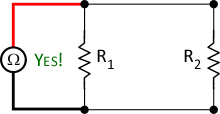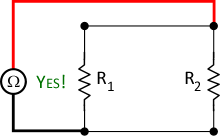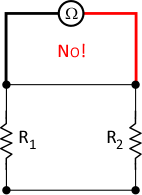- Computers are NOT needed for lab this week
- Even though students used a voltmeter and ammeter in the previous experiment, most still won't know the proper way of connecting each meter, so you'll need to watch them carefully. You'll need the patience of Job this week; many will screw up the ammeter connection. Every. Time. *sigh*
- There are 7 wires at each station this week, which increases the probability of connecting something incorrectly. That, and the fact that this experiment sometimes follows February break, means that they have completely forgotten how to use an ammeter and voltmeter. Hilarity ensues.
- It might help to remind them of the proper preparation of each meter beforehand: 1 wire in the ammeter, 2 wires in the voltmeter. Tell them to leave the wires in the meter, but many will continue to remove them. Every. Single. Time.
- Two resistors (R1 = 1.5 kΩ; R2 = 5 kΩ) are connected in series and parallel. The most difficult connection for them is the placement of ammeter A1 used to measure the current through R1 in the parallel circuit. Occasionally someone will figure it out on their own, but you'll need to talk most of them through this
- Check that the resistor block terminals are tight. They will loosen with use, causing fluctuations in measurements
- Parallel circuits: Many will have difficulty connecting the resistors and bulbs in parallel. Have them place both resistors/bulbs physically parallel to each other and the power supply, and then have them make the connections to the power supply
- Bulbs in parallel: When you hear them say "Why aren't these working?", the problem is either:
- they have a bulb that is not screwed tightly into its holder, or
- they've shorted out both bulbs (most likely)
- Fortunately, the current limiter setting on the power supply (the white line should be at the 12 o'clock position) keeps them from blowing themselves to smithereens
- Series short circuit: They should ask you to check their circuit (if they're reading the damn directions). Have them turn on the power supply (set to 7 volts), then have them close the switch. Ask them to tell you what happened (the shorted bulb goes out, the other bulb gets brighter) and ask them to explain why each happened. Have them think in terms of the voltage across the bulb
- There are three ways to connect an ohmmeter to the parallel pair of resistors; two will give a proper reading, and one doesn't work:
 |
 |
 |
| Figure 1: Across R1 or R2 |
Figure 2: Across either corner |
Figure 3: Measures resistance of wire |
|


